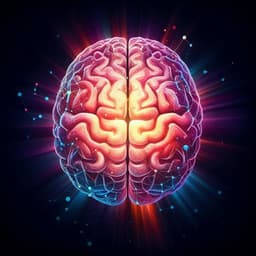
Medicine and Health
A systematic review of alterations in sensorimotor networks following stroke: implications for integration and functional outcomes across recovery stages
N. S. A. Sahrizan, N. Yahya, et al.
Stroke alters functional connectivity within the sensorimotor network (SMN), but many studies report gradual improvement through compensatory mechanisms, cortical reorganisation, and functional rewiring, with recovery shaped by lesion location. This research was conducted by Authors present in <Authors> tag.
~3 min • Beginner • English
Introduction
A stroke disrupts blood supply due to occlusion or hemorrhage, causing neuronal death and widespread changes in brain network connectivity. Post-stroke, the brain’s network can evolve toward more complex and random topology during rehabilitation, forming new connections and reorganizing functional connectivity to compensate for damage. The sensorimotor network (SMN)—including primary motor cortex (M1), somatosensory cortex, premotor cortex (PMC), and supplementary motor area (SMA)—integrates sensory inputs with motor planning and execution, and interacts with higher-order networks (attention, memory, decision-making) and subcortical structures (basal ganglia, cerebellum). Stroke location critically affects outcomes; damage to SMN regions leads to sensorimotor deficits that hinder goal-directed movements and daily functioning. While neuroplasticity and functional reorganization drive recovery, mechanisms depend on brain state, chronicity, and lesion extent. This review evaluates alterations in SMN among stroke patients across recovery stages, emphasizing sensorimotor integration and functional consequences, leveraging fMRI to characterize connectivity changes, their dynamics, and implications for rehabilitation.
Literature Review
Prior work shows post-stroke brain network evolution with compensatory connections and reorganization (e.g., increased complexity/randomness of networks). The SMN’s role spans planning, execution, control of voluntary movements, and proprioception, while coupling to cognitive and subcortical systems (basal ganglia, cerebellum). Stroke-induced deficits in integrating sensory inputs to shape motor output are linked to lesion location (e.g., M1 damage causing contralateral weakness/paralysis), with recovery mediated by resolution of harmful local factors and neuroplasticity. Early and longitudinal studies indicate functional reorganization from acute to chronic stages, including contralesional recruitment, interhemispheric adjustments, and cortical rewiring. The literature highlights heterogeneity by lesion site (basal ganglia, internal capsule, corona radiata, pontine, thalamus), and suggests that SMN alterations correlate with motor assessments like Fugl-Meyer Assessment (FMA). fMRI has been pivotal in mapping these changes, revealing both intra- and inter-network disruptions and compensations that influence motor and cognitive outcomes.
Methodology
Design: Systematic review following PRISMA guidelines, registered in PROSPERO. Databases and search date: PubMed and Scopus searched in April 2024; reference lists cross-checked via Google Scholar. Keywords included terms for SMN regions (sensorimotor, motor cortex, supplementary motor area), stroke types (stroke, acute stroke, ischemic, hemorrhagic), and imaging modality (functional MRI, fMRI). Study selection: One reviewer screened titles/abstracts; full texts were assessed against eligibility criteria; two additional reviewers verified and resolved discrepancies. Inclusion criteria: Adults (>18 years) with stroke; motor assessment using full Fugl-Meyer Assessment (FMA) for extremities; post-stroke assessment using fMRI; comparison with healthy controls; original peer-reviewed studies in English. Exclusion criteria: Non-English, no full text, pre-clinical studies, case reports/series, reviews, letters; studies using other imaging modalities (CT, PET, ultrasound, navigated TMS). PRISMA flow: After removing duplicates, 1,999 records were screened; 1,762 excluded on title/abstract; 237 full-texts assessed; 219 excluded (not fMRI: 25; no FMA: 124; intervention: 50; not whole extremity: 17; no full text: 3); 20 studies included. Data extraction: Author(s), year, country, participants, mean age±SD, stroke type, post-stroke onset, lesion location, motor assessments, fMRI analyses. Quality assessment: National Heart, Lung, and Blood Institute Quality Assessment Tool for Observational Cohort and Cross-Sectional Studies applied; most studies rated moderate to high quality. Study characteristics: 20 studies; 618 stroke patients and 606 healthy controls; majority conducted in China (n=16), with others in South Korea (n=2), Japan (n=1), USA (n=1). Designs included longitudinal (n=9; 10 days to 6 months follow-up) and cross-sectional studies spanning acute (<2 weeks), subacute (up to 3 months), and chronic (>6 months) stages. fMRI analyses used: voxel-based morphometry, general linear model, seed-based analysis, independent component analysis, degree centrality, intra/inter-network analyses; additional motor/cognitive tasks used in some studies (e.g., Wolf motor, box and blocks, grip strength, Trail Making Test, Flanker, Number back, Spatial back).
Key Findings
- Across 20 studies (618 stroke patients; 606 healthy controls), stroke consistently altered functional connectivity (FC) within the SMN; many studies reported time-dependent improvements in FC attributed to compensatory mechanisms, cortical reorganization, and functional rewiring. - Lesion location influenced outcomes: basal ganglia lesions prominently affected frontal connectivity (e.g., precuneus, SMA, superior frontal gyrus), with frequency-specific FC changes and longitudinal shifts toward contralesional MPFC/MFG/insula; pontine lesions showed decreased FC within DMN, visual, and language networks, reduced VIS-SMN inter-network FC, and distinct left-right pontine CBF/FC trajectories; supratentorial strokes exhibited greater interhemispheric disruption and poorer motor recovery than infratentorial strokes; left-hemisphere lesions more often disrupted SMN connectivity than right. - Fugl-Meyer Assessment (FMA) trajectories: within 2 weeks, mostly moderate motor impairment, with some severe cases; by 1 month and 3 months, significant FMA improvements, sometimes remaining moderate; limited studies at 6 months continued to show improvement but persistent deficits in some. Side-specific findings included lower FMA for supratentorial vs infratentorial strokes, and lower scores for left vs right pontine strokes. - Resting-state and task-based fMRI: mixed patterns of increased or decreased intra- and inter-network FC across recovery stages. Early increases in FC in acute phase followed by decreases in subacute phase; contralesional SMC activation in early subacute; increased ALFF in bilateral PMC at 12 weeks; decreased inter-network FC between ipsilesional SMC and contralesional cerebellum linked to poorer hand function; persistent altered connectivity involving SMC, occipital cortex, and MFG up to 6 months. - Correlations with clinical measures: positive correlations reported between SMA/M1 (PreCG) connectivity and FMA in some studies; negative correlations in contralesional motor regions in others; several studies reported no correlation, underscoring methodological and population variability. Cognitive associations included negative correlations between FC and attention/working memory/memory scores in pontine stroke. - Overall, the brain shows capacity for neuroplasticity and functional reorganization post-stroke, with recovery patterns strongly modulated by lesion site, chronicity, and network-level interactions.
Discussion
The reviewed evidence indicates that stroke induces widespread, dynamic changes in SMN connectivity that underlie motor deficits and recovery. Early disruptions in local circuits and interhemispheric coupling impair motor coordination and strength, while adaptive reorganization—both within the SMN and across cognitive and cerebellar networks—supports functional improvements. Lesion-specific patterns emerged: basal ganglia strokes affect frontal connectivity and higher-order control; pontine lesions impact visual/language networks and DMN, reflecting diaschisis along cerebrocerebellar pathways; supratentorial strokes disrupt interhemispheric balance more than infratentorial ones. Recovery mechanisms span acute inflammatory-excitotoxic processes to subacute neuroplasticity with compensatory inter- and intra-hemispheric changes, stabilizing in the chronic phase though plasticity persists. These findings advocate for rehabilitation strategies tailored to lesion location and recovery stage, engaging key regions (M1/PreCG, SMA) and restoring inter-network coupling. The variability of FC-FMA relationships and methodological heterogeneity highlight the need for harmonized protocols and larger longitudinal cohorts to refine biomarkers and optimize personalized interventions.
Conclusion
Post-stroke SMN alterations reflect a complex, dynamic reorganization of functional connectivity that shapes motor recovery trajectories. Compensatory mechanisms and neuroplasticity facilitate improvements, but their extent depends on lesion site, severity, and neural reserve. Understanding temporal-spatial patterns of SMN changes can guide individualized, targeted rehabilitation to optimize outcomes. Future work should integrate multimodal imaging (DTI, task-fMRI), electrophysiology, AI-driven predictive modeling, and BCI-based approaches, and evaluate neuromodulation (TMS, tDCS) to modulate SMN connectivity and promote plasticity. Larger, harmonized longitudinal studies are needed to translate connectivity findings into clinical protocols and improve quality of life for stroke survivors.
Limitations
- Geographic/ethnic bias: majority of included studies from Asian populations, limiting generalizability across ethnic groups and healthcare contexts. - Clinical heterogeneity: variability in lesion size, location (e.g., basal ganglia, pontine), and stroke subtype (ischemic vs hemorrhagic) complicates comparisons and predictive modeling. - Methodological heterogeneity: differences in MRI acquisition, preprocessing, FC metrics (seed-based vs ICA vs dynamic measures), sample sizes, and statistics reduce reproducibility and hinder meta-analytic synthesis; small samples may inflate false positives. - Temporal dynamics unresolved: critical windows for targeted interventions and precise trajectories of FC changes across recovery stages remain unclear; interactions between motor and cognitive networks need deeper investigation. - Translational gap: FC alterations are not yet routinely actionable for personalized rehabilitation; need for AI models, multimodal integration (DTI + rs-fMRI), and neuromodulation trials. - Search scope: restriction to PubMed and Scopus (with Google Scholar cross-check) may have missed studies indexed elsewhere (e.g., Web of Science, Embase).
Related Publications
Explore these studies to deepen your understanding of the subject.







